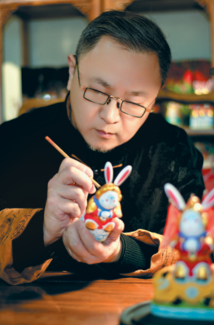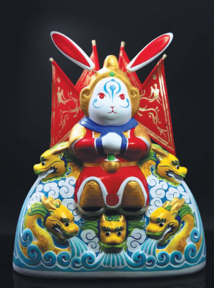Animal instinct helps revive heritage
Shandong craftsman resurrects and modernizes traditional rabbit god figurines, Li Yingxue reports.

As you walk into the Shandong Arts and Crafts Exhibition Center, you are greeted by a magnificent sight: a larger-than-life rabbit. Perched atop an auspicious cloud, the Tuzi Wang, or "lord rabbit", is resplendent in a golden helmet, armor and a flowing red robe, complete with four banners on its back.
Its face is adorned with an artistically painted Chinese character, quan, and the cloud beneath it features the landscape of Baotu Spring, one of the most famous scenic spots in Jinan, the capital city of Shandong province, East China.
The creator of the rabbit figure is Yang Feng, 52, an inheritor of this Shandong intangible cultural heritage. Located on the second floor of the exhibition center is his studio, where he displays his works, in different designs and sizes, as well as the legends and stories associated with them.
From a large rabbit general who has an imposing and majestic appearance to a small rabbit baby who looks cute and adorable, Yang's artistic works are exhibited. Yang named his works "Quancheng Tuzi Wang", with quancheng meaning "the capital of springs" — a nickname for his hometown, Jinan.
After dedicating two decades to perfecting his craft, Yang is committed to preserving and evolving the traditional skill of creating the lord rabbit in his own unique style.
"For me, crafting the rabbit is not just a job, but a lifelong career that I am passionate about," he says.
Hou Yangjun, the deputy secretary-general of the Chinese Folk Literature and Art Association, explains that the practice of worshiping the moon with the rabbit god can be traced back to the Ming Dynasty (1368-1644) and was practiced mainly in Beijing, Tianjin and Shandong's Jinan and Qingdao.
"The rabbit god is known as Tu'er Ye in Beijing and Tuzi Wang in Jinan. Despite minor differences in their appearance, both of them share the same origins and have been passed down for several centuries. They are traditionally crafted from mud and clay," Hou says.
According to the legend, the people of Jinan were once plagued by an illness for which they had no cure. In their desperation, they turned to the gods for help. The rabbit god, residing in the moon palace, heard their plea and descended to Earth with a medicine that could heal the people.
The immortal proceeded to pour the elixir into 72 springs throughout Jinan, and as people drank the water, the epidemic was eradicated and the people of Jinan were saved.
As a result, a folk tradition emerged in Jinan where citizens worship a clay rabbit god named Tuzi Wang during Mid-Autumn Festival, which is now considered a symbol of safety and good health in the city.
Yang heard about the tales in childhood and wanted to get one, but he never found it. Then, after helping his classmate to repair a colored mud piece, he realized that he could make one on his own.
In 2004, Yang noticed there was a competition to develop a souvenir for Jinan which needed to represent local culture and be portable. Yang thought that the rabbit god fit all the qualifications and spent a whole month making one from scratch.
He won top prize at the competition, which encouraged him to quit his job as an interior designer and devote himself to making effigies of the rabbit god.
Spring into action
There were not many clues left about what the traditional lord rabbit looked like. After several dead ends, Wang found a book about folk toys in Shandong which recorded their myths, production procedures and photos of them. He was thrilled.
He learned from the book that, at its peak, there were around 30 stores across Jinan making models of the lord rabbit, and each one had its own unique features. However, the skill had been fading since the 1960s.
"I didn't want to replicate the previous ones recorded in the book, but to find my own style," he says.
Yang made a plan to create 72 rabbit statues to represent the 72 natural springs in Jinan and has finished several already. On the basis of the classic pattern, Yang incorporates elements of each location, including the spring water, landscape and poems, as well as the spring's name, in the character.
According to Yang, the raw material to make rabbits is usually mud taken from the Yellow River. The water from the Yellow River will naturally clear the sand and leave the fine river mud, which has good adhesion and strong plasticity with no impurities.
It takes a dozen procedures and over 30 steps for Yang to make a lord rabbit, from molding the mud to painting the patterns, and he also needs time to design and modify the piece.
Yang has added a new procedure, that of firing in a kiln. "I've learned pottery craft and that procedure is similar to the way the terracotta warriors were made," he says.
Yang worked for seven to eight hours to make it firm.
"It can absorb the water in the pigment and make the color effect better," he explains.
It usually takes him a week to finish one batch of statues, but sometimes it can cost more than a month.
Speaking of the difference between Tu'er Ye and Tuzi Wang, Yang says one main element is the ears — the design of those on the former are fixed, while the ears of the latter are linked with spring and the color is a bit different.
The second difference is that Tu'er Ye's face has no painting while Tuzi Wang's face does, Yang says, adding that the traditional Tu'er Ye has one banner on its back — or if it does, it's just one — but Tuzi Wang usually has four.
Yang recalls his first work was bought by a tourist from New Zealand, and was told by the customer that rabbits have an auspicious meaning in their country.
In 2006, he went to Singapore to take part in an art, culture and tourism exhibition. "Many tourists bought them as a gift to take back to their country. I hope they can also be a carrier of traditional Chinese culture to more places," he says.
He founded his studio in 2007 and, after moving several times, he relocated the studio to the Shandong Arts and Crafts Exhibition Center last year.
Besides his working area and a display of his statues, there are also many cultural creative products featuring the lord rabbit, including T-shirts, puzzles, badges and notebooks, as well as an area for people to try their hands at making a rabbit figure themselves.
During the weekends and holidays, many locals bring their children to Yang's store to make their own rabbit statues. There are also tourists from across the country who come specially to see his works.
An old woman came to his studio and shared with Yang her childhood stories about the lord rabbit: When she was a child, each time she got sick, her father would buy her a new rabbit figure.
"When older people share with me their stories, there is light shining in their eyes," Yang says.
"I know the one in their memory is not the same as my creations, yet mine can remind them of old, happy times, which gives me a warm feeling."
As 2023 marks the Year of the Rabbit, Yang has expressed his intentions to further expand his artistic repertoire by creating more new works, while also exploring collaborations with other art forms to generate fresh sparks of creativity.
Moreover, Yang has been actively engaging with other intangible cultural heritage inheritors in Jinan, holding discussions on ways to incorporate additional elements of intangible cultural heritage into his rabbit creations. He says that he aims to develop new lord rabbit figures that showcase the rich cultural heritage of Jinan.
"I keep thinking how to infuse more elements of Jinan into my works. I hope that tourists can see the variety and get to know the stories behind them, as well as Jinan's history and culture, and fall in love with the city," Yang says.



Today's Top News
- Recall vote shows 'Taiwan independence' separatism doomed to fail
- China holds third rehearsal for event marking 80th anniversary of victory over Japanese aggression, fascism
- China activates emergency response as Typhoon Kajiki approaches
- Putin-Zelensky meeting not being planned, intense mutual attacks persist
- Ancient civilizations should adjust ties
- China, Japan, ROK urgently need an FTA































